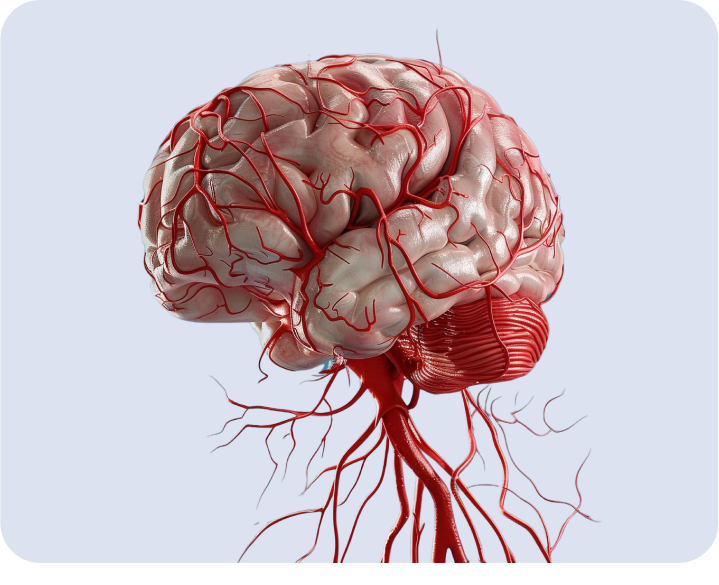Library - Page 10
Registered on ClinicalTrials
The effectiveness and safety of the drug Mexol Forte 250 with sequential therapy of patients with chronic brain ischemia
Authors:
N.G. Kataeva 1 , T.A. Zamoshchina 1.2 , M.V. Svetlik 1.2
1 FSBEI in Siberian State Medical University Mini Health of Russia, Tomsk, Russia;
2 FGAOU in National Research Tomsk State University, Tomsk, Russia
Study of the effectiveness and safety of the drug Mexol Fort 250 as part of consecutive therapy in patients with a hemisphere ischemic stroke in acute and early recovery periods
Authors:
M.A. Loskutnikov, M.A. Domashenko, T.M. Vakin, I.A. Trushina, V.I. Konstantinov, O.S. Proskuryakova, E.P. Schukina
Elderly patient with cerebrovascular pathology: Features of examination and conduct
Authors:
E.V. Ekusheva, E.A. Mkhitaryan
The role of oxidant stress in the development of vascular cognitive disorders
Author:
A.N. Bogolepova
FGAOU in Russian National Research Medical University named after N.I. Pirogov »Ministry of Health of Russia, Moscow, Russia;
FSBI "Federal Center for Brain and Neurotechnology" FMBA of Russia, Moscow, Russia
The effectiveness and safety of the use of ethylmethylhydroxypyridine of succinate in patients with chronic brain ischemia
Authors:
M.V. Zhuravlev 1.2 , A.B. Prokofiev 1.2 , S.Yu. Serebrova 1.2 , N.S. Vasyukova 3 , E.Yu. Demchenkova 1 , V.V. Arkhipov 1
1 FSBI “Scientific Center for Expertise of Medical Application” of the Ministry of Health of Russia, Moscow, Russia;
2 FGAOU VO "First Moscow State Medical University named after THEM. Sechenov »Ministry of Health of Russia (Sechenov University), Moscow, Russia;
3 FGBNU “Federal Scientific Center-All-Russian Research Institute of Experimental Veterinary Medicine named after K.I. Scriabin and Ya.R. Kovalenko of the Russian Academy of Sciences ", Moscow, Russia
The effectiveness of the use of ethylmethylhydroxypyridine of succinate in the restoration treatment of patients who have undergone ischemic stroke
Authors:
M.V. Zhuravlev 1.2 , A.B. Prokofiev 1.2 , V.V. Arkhipov 1 , S.Yu. Serebrova 1.2 , G.I. Gorodetskaya 1.2 , O.A. Demidova 1
1 FSBI “Scientific Center for Expertise of Medical Application” of the Ministry of Health of Russia, Moscow, Russia;
2 FGAOU VO "First Moscow State Medical University named after THEM. Sechenov "Ministry of Health of Russia (Sechenov University), Moscow, Russia
The effectiveness and safety of the drug Mexidol Fort 250 in the framework of prolonged consistent therapy in patients with ischemic stroke in a carotide pool
Authors:
I.A. Strelnikova 1 , A.A. Svetkina 1.2 , O.V. Androfagin 1
1 GBUZ "Samara Regional Clinical Hospital named after V.D. Seredavina "of the Ministry of Health of the Samara Region, Samara, Russia;
2 FSBEI in Samara State Medical University of the Ministry of Health of Russia, Samara, Russia
The results of the sequential use of Mexidol and Mexidol Forte 250 in patients with chronic brain ischemia
Author:
Yu.V. Abramenko
FSBEI in the Tver State Medical University of the Ministry of Health of Russia, Tver, Russia
The modern concept of cognitive reserve
Author:
Koberta N.N., Tabeeva G.R.
Place of publication:
NEUROLOGY. NEUROPSYCHIATRY. Psychosomatics, 2019
Vascular depression and cognitive dysfunction
Author:
Bogolepova A.N.
Place of publication:
Neurology, neuropsychiatry, psychosomatics. 2019
The study of the effectiveness and safety of the use of Mexidol and Mexidol Forte 250 in patients with chronic brain ischemia
Author:
V.A. Kutashov, O.V. Ulyanova
FSBEI in Voronezh State Medical University named after N.N. Burdenko »Ministry of Health of Russia, Voronezh, Russia
The effectiveness and safety of the drug Mexol Forte 250 in the framework of consecutive therapy in patients with chronic brain ischemia
Author:
E.I. Chukanova, A.S. Chukanova
Department of Neurology, Neurosurgery and Medical Genetics of Faculty of Faculty of Faculty of FSBEI in "RNIMU named after N.I. Pirogov »Ministry of Health of Russia, Moscow, Russia
Review of clinical recommendations for the treatment and prevention of ischemic stroke
Author:
A.I. Fedin, K.R. Badalyan
FSBEI in Russian National Research Medical University named after N.I. Pirogov »Ministry of Health of Russia, Moscow, Russia
The prospects for the use of Mexidol for the treatment of patients suffering from neurosenate hearing loss and cerebrovascular failure
Author:
N.L. Kunelskaya, Yu.V. Levina, E.S. Yanyushkina, D.S. Ogorodnikov, E.V. Larionova
Combined use of Mexidol with well -known drugs
Author:
T.A. Voronina, E.A. Ivanova
FGBNU "Research Institute of Pharmacology named after V.V. Zakusova ”, Moscow, Russia
Assessment of rheological indicators of blood in patients with acute ischemic stroke when using the drug Mexidol
Authors:
D.M. Plotnikov 1 , M.N. Stegmeier 1 , O.I. Aliyev 2
1 Department of Neurology and Neurosurgery of the Federal State Budgetary Institution “Siberian State Medical University” of the Ministry of Health of Russia, Tomsk, Russia;
2 research institute pharmacology and regenerative therapy named after E.D. Goldberg Tomsk Nimets of the Russian Academy of Sciences, Tomsk, Russia
Information is intended for medical and pharmaceutical workers. This information cannot serve as a replacement for a doctor’s consultation.
Source of photos and images Shutterstock.com














